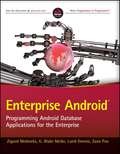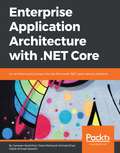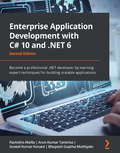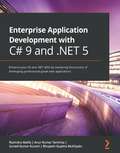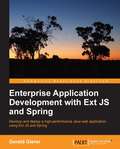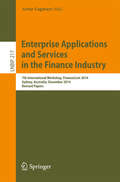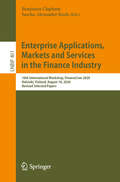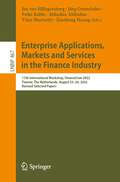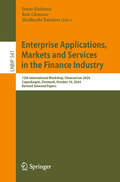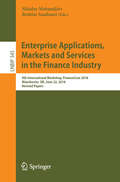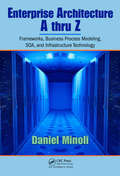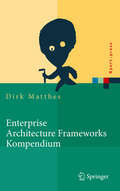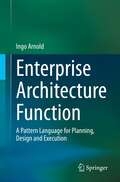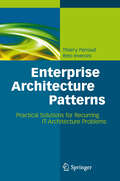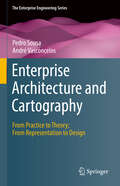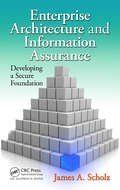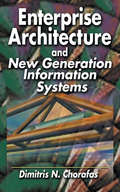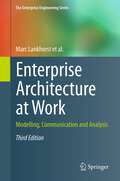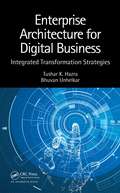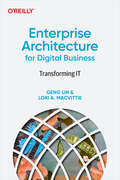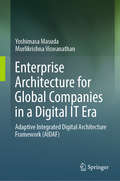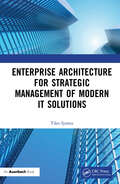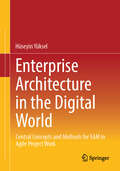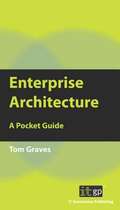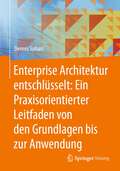- Table View
- List View
Enterprise Android
by G. Blake Meike Zigurd Mednieks Laird Dornin Zane PanThe definitive guide to building data-driven Android applications for enterprise systemsAndroid devices represent a rapidly growing share of the mobile device market. With the release of Android 4, they are moving beyond consumer applications into corporate/enterprise use. Developers who want to start building data-driven Android applications that integrate with enterprise systems will learn how with this book. In the tradition of Wrox Professional guides, it thoroughly covers sharing and displaying data, transmitting data to enterprise applications, and much more.Shows Android developers who are not familiar with database development how to design and build data-driven applications for Android devices and integrate them with existing enterprise systems Explores how to collect and store data using SQLite, share data using content providers, and display data using adapters Covers migrating data using various methods and tools; transmitting data to the enterprise using web services; serializing, securing, and synchronizing data Shows how to take advantage of the built-in capabilities of the Android OS to integrate applications into enterprise class systemsEnterprise Android prepares any Android developer to start creating data-intensive applications that today's businesses demand.
Enterprise Application Architecture with .NET Core
by Ovais Mehboob Khan Ganesan Senthilvel Habib Ahmed QureshiArchitect and design highly scalable, robust, clean and highly performant applications in .NET Core 1.0 About This Book • Incorporate architectural soft-skills such as DevOps and Agile methodologies to enhance program-level objectives • Gain knowledge of architectural approaches on the likes of SOA architecture and microservices to provide traceability and rationale for architectural decisions • Explore a variety of practical use cases and code examples to implement the tools and techniques described in the book Who This Book Is For This book is for experienced .NET developers who are aspiring to become architects of enterprise-grade applications, as well as software architects who would like to leverage .NET to create effective blueprints of applications. What You Will Learn • Grasp the important aspects and best practices of application lifecycle management • Leverage the popular ALM tools, application insights, and their usage to monitor performance, testability, and optimization tools in an enterprise • Explore various authentication models such as social media-based authentication, 2FA and OpenID Connect, learn authorization techniques • Explore Azure with various solution approaches for Microservices and Serverless architecture along with Docker containers • Gain knowledge about the recent market trends and practices and how they can be achieved with .NET Core and Microsoft tools and technologies In Detail If you want to design and develop enterprise applications using .NET Core as the development framework and learn about industry-wide best practices and guidelines, then this book is for you. The book starts with a brief introduction to enterprise architecture, which will help you to understand what enterprise architecture is and what the key components are. It will then teach you about the types of patterns and the principles of software development, and explain the various aspects of distributed computing to keep your applications effective and scalable. These chapters act as a catalyst to start the practical implementation, and design and develop applications using different architectural approaches, such as layered architecture, service oriented architecture, microservices and cloud-specific solutions. Gradually, you will learn about the different approaches and models of the Security framework and explore various authentication models and authorization techniques, such as social media-based authentication and safe storage using app secrets. By the end of the book, you will get to know the concepts and usage of the emerging fields, such as DevOps, BigData, architectural practices, and Artificial Intelligence. Style and approach Filled with examples and use cases, this guide takes a no-nonsense approach to show you the best tools and techniques required to become a successful software architect.
Enterprise Application Development with C# 10 and .NET 6: Become a professional .NET developer by learning expert techniques for building scalable applications, 2nd Edition
by Ravindra Akella Arun Kumar Tamirisa Suneel Kumar Kunani Bhupesh Guptha MuthiyaluA comprehensive guide to every important component of C# and .NET 6 required to build robust enterprise web applicationsKey FeaturesExplore the advanced features of C# and .NET 6 to enhance your code and productivityFollow clear and easy instructions for building an end-to-end enterprise applicationLearn how to build scalable web applications and host them on the cloudBook DescriptionBuilding production-ready enterprise applications can be a challenging task due to the overabundance of tools and their different versions that make app development complex. This book simplifies the process with an end-to-end road map for building enterprise applications from scratch using the latest features of .NET Core 6 and C# 10.Throughout the book, you'll work on creating an enterprise app, adding a key component to the app with each chapter, before ?nally getting it ready for testing and deployment. You'll learn concepts relating to advanced data structures, the Entity Framework Core, parallel programming, and dependency injection. As you progress, you'll cover various authentication and authorization schemes provided by .NET Core to make your apps and APIs secure. The book then shows you how the latest Microsoft Visual Studio and C# 10 help you simplify developer tasks and shares tips and tricks in Visual Studio to improve your productivity. You'll discover various testing techniques, such as unit testing and performance testing, as well as di?erent methods to deploy enterprise apps.By the end of this book, you'll be able to create enterprise apps using the powerful features of .NET 6 and deploy them to the cloud while working with various cloud components using Azure.What you will learnDesign enterprise apps by making the most of the latest features of .NET 6Discover di?erent layers of an app, such as the data layer, API layer, and web layerExplore end-to-end architecture by implementing an enterprise web app using .NET and C# 10 and deploying it on AzureFocus on the core concepts of web application development and implement them in .NET 6Integrate the new .NET 6 health and performance check APIs into your appExplore MAUI and build an application targeting multiple platforms - Android, iOS, and WindowsWho this book is forIf you are a developer, architect, or senior programmer, this book will show you how to leverage the features of .NET 6 and the C# language, as well as help you grasp essential techniques to build your skills.
Enterprise Application Development with C# 9 and .NET 5
by Ravindra AkellaIf you are a developer, architect, or senior programmer who wants to fully leverage the .NET Framework and C# language features and techniques to take your career to the next level, this book is for you. Basic to intermediate knowledge of .NET Framework or .NET Core and C# programming will help you to make the most out of this book.
Enterprise Application Development with Ext JS and Spring
by Gerald GiererAn easy-to-follow tutorial, that breaks down the enterprise application development journey into easy to understand phases documented by clear examples and concise explanations.If you are an intermediate developer with a good understanding of Java, JavaScript and web development concepts, this book is ideal for you. Basic ExtJS development experience, including an understanding of the framework APIs is needed by those of you who are interested in this book. Regardless of your experience and background, the practical examples provided in this book are written in a way that thoroughly covers each concept before moving on to the next chapter.
Enterprise Applications and Services in the Finance Industry
by Artur LugmayrThis book constitutes the proceedings of the 7th International Workshop on Enterprise Applications and Services in the Finance Industry, FinanceCom 2014, held in Sydney, Australia, on December 12, 2014. The workshop spans multiple disciplines, including technical, service, economic, sociological, and behavioral sciences. It reflects on technologically enabled opportunities, implications, and changes due to the introduction of new business models or regulations related to the financial services industry and the financial markets. The nine papers presented were carefully reviewed and selected from numerous submissions.
Enterprise Applications, Markets and Services in the Finance Industry: 10th International Workshop, FinanceCom 2020, Helsinki, Finland, August 18, 2020, Revised Selected Papers (Lecture Notes in Business Information Processing #401)
by Benjamin Clapham Jascha-Alexander KochThis book constitutes the revised selected papers from the 10th International Workshop on Enterprise Applications, Markets and Services in the Finance Industry, FinanceCom 2020, held in Helsinki, Finland, in August 2020. Due to the COVID-19 pandemic the conference took place virtually.The 6 full papers presented together with 1 extended abstract in this volume were carefully reviewed and selected from a total of 14 submissions to the workshop.They are grouped in topical sections named Machine Learning Applications in Trading and Financial Markets, Fraud Detection and Information Generation in Finance, and Alternative Trading and Investment Offerings by FinTechs.The workshop spans multiple disciplines, including analytical, technical, service, economic, sociological and behavioral sciences.
Enterprise Applications, Markets and Services in the Finance Industry: 11th International Workshop, FinanceCom 2022, Twente, The Netherlands, August 23–24, 2022, Revised Selected Papers (Lecture Notes in Business Information Processing #467)
by Jos Van Hillegersberg Jörg Osterrieder Fethi Rabhi Abhishta Abhishta Vijay Marisetty Xiaohong HuangThis book constitutes revised selected papers from the 11th International Workshop on Enterprise Applications, Markets and Services in the Finance Industry, FinanceCom 2022, held in Twente, The Netherlands, in August 2022.The 8 full papers presented in this volume were carefully reviewed and selected from a total of 25 submissions. They deal with the adoption of innovative technologies in the financial services industry. The conference features four main themes: networks and business models, financial markets, IT and implementations, and new emerging digital and virtual financial markets.
Enterprise Applications, Markets and Services in the Finance Industry: 12th International Workshop, FinanceCom 2024, Copenhagen, Denmark, October 10, 2024, Revised Selected Papers (Lecture Notes in Business Information Processing #541)
by Jonas Hedman Rob Gleasure Madhushi BandaraThis book constitutes revised selected papers from the 12th International Workshop on Enterprise Applications, Markets and Services in the Finance Industry, FinanceCom 2024, held in Copenhagen, Denmark, on October 10, 2024. The 5 full papers presented in this volume were carefully reviewed and selected from a total of 8 submissions. They deal with the adoption of innovative technologies in the financial services industry. In addition, two invited papers which are closely related with the conference topics were also included after a thorough review. The conference features five main themes: networks and business models, financial markets, IT and implementations, new emerging digital and virtual financial markets, and AI revolution in finance.
Enterprise Applications, Markets and Services in the Finance Industry: 9th International Workshop, FinanceCom 2018, Manchester, UK, June 22, 2018, Revised Papers (Lecture Notes in Business Information Processing #345)
by Nikolay Mehandjiev Brahim SaadouniThis book constitutes revised selected papers from the 9th International Workshop on Enterprise Applications, Markets and Services in the Finance Industry, FinanceCom 2018, held in Manchester, UK, in June 2018. The 11 papers presented in this volume were carefully reviewed and selected from 18 submissions. They were organized in topical sections named: financial innovation; market data analytics; and semantic modelling.
Enterprise Architecture A to Z: Frameworks, Business Process Modeling, SOA, and Infrastructure Technology
by Daniel MinoliEnterprise Architecture A to Z examines cost-saving trends in architecture planning, administration, and management. The text begins by evaluating the role of Enterprise Architecture planning and Service-Oriented Architecture (SOA) modeling. It provides an extensive review of the most widely-deployed architecture framework models, including The Open Group Architecture and Zachman Architectural Frameworks, as well as formal architecture standards. The first part of the text focuses on the upper layers of the architecture framework, while the second part focuses on the technology architecture. Additional coverage discusses Ethernet, WAN, Internet communication technologies, broadband, and chargeback models.
Enterprise Architecture Frameworks Kompendium
by Dirk MatthesIn dem Band werden 50 Enterprise Architecture Frameworks (EAF) ausführlich behandelt und 45 weitere hinsichtlich ihrer Intention kurz und prägnant dargestellt. Die detaillierten Beschreibungen erlauben durch ein einheitliches Raster den Vergleich unterschiedlicher EAF. Sie enthalten Informationen zum Entwickler, zu Versionen, zur Marktrelevanz, zu Abhängigkeiten, Verfügbarkeit, unterstützenden Tools sowie Anschaffungskosten. Die Unterstützungsvielfalt, die Frameworks bieten, demonstriert der Autor anhand eines Anwendungsszenarios.
Enterprise Architecture Function: A Pattern Language for Planning, Design and Execution
by Ingo ArnoldThis book provides a method to plan, develop, validate, or evolve the design of an enterprise architecture function so that it fully meets the organization’s needs. The reader will benefit from this book in two ways. First, it provides a structured overview and orientation to the subject of architecture from an architecture function perspective. Second, it guides through the process of planning, building, and operating your own architecture organization based on a generic architecture function blueprint presented in the form of a pattern language offering a structured means for navigating, contextualizing, combining, and composing the architecture function patterns. The book is structured in six chapters. Chapter 1 “Introduction” explains the starting position and objectives of the book and introduces key concepts that will be explained further in subsequent chapters. Chapter 2 “Architecture Function Pattern Language” introduces the concepts of pattern, pattern catalogue, pattern topology, and ontology and explains how these concepts are combined to form a pattern language for planning, designing, and operating an architecture function. Next, Chapter 3 “Architecture Function – Context“ introduces concepts that are crucial for understanding the challenges that an architecture function faces and presents a generic schema for the business organizations and value chain. Chapter 4 “Architecture Function – Challenge” looks at an architecture function from a black box perspective and outlines the expectations and requirements that companies place on architecture organizations. It discusses the building blocks of an architecture function, the services it provides along the enterprise value chain, and the quality attributes that enterprises expect from their functions. Chapter 5 “Architecture Function – Constitution” then shifts from a black-box perspective to a white-box perspective and outlines the generic design of an architecture function in order to realize functional and quality-related requirements. Chapter 6 “Pattern Catalogue“ eventually introduces the pattern catalogue with a total of 48 architecture function patterns. These patterns suggest designs for collaboration between the architecture function and enterprise organizations, for the elaboration and development of enterprise services along the enterprise value chain, or for aligning architecture governance with enterprise governance. The book is intended for a broad readership, including enterprise, domain, and solution architects, lecturers and students, and anyone else interested in understanding the value proposition, responsibilities, outcomes, methods, and practices of architecture functions. It introduces the basic concepts and theories needed to understand the pattern language presented and the patterns it summarizes.
Enterprise Architecture Patterns: Practical Solutions for Recurring IT-Architecture Problems
by Reto Inversini Thierry PerroudEvery enterprise architect faces similar problems when designing and governing the enterprise architecture of a medium to large enterprise. Design patterns are a well-established concept in software engineering, used to define universally applicable solution schemes. By applying this approach to enterprise architectures, recurring problems in the design and implementation of enterprise architectures can be solved over all layers, from the business layer to the application and data layer down to the technology layer. Inversini and Perroud describe patterns at the level of enterprise architecture, which they refer to as Enterprise Architecture Patterns. These patterns are motivated by recurring problems originating from both the business and the underlying application, or from data and technology architectures of an enterprise such as identity and access management or integration needs. The Enterprise Architecture Patterns help in planning the technological and organizational landscape of an enterprise and its information technology, and are easily embedded into frameworks such as TOGAF, Zachman or FEA. This book is aimed at enterprise architects, software architects, project leaders, business consultants and everyone concerned with questions of IT and enterprise architecture and provides them with a comprehensive catalogue of ready-to-use patterns as well as an extensive theoretical framework to define their own new patterns.
Enterprise Architecture and Cartography: From Practice to Theory; From Representation to Design (The Enterprise Engineering Series)
by Pedro Sousa André VasconcelosThis textbook provides guidance to both students and practitioners of enterprise architecture (EA) on how to develop and maintain enterprise models. Rather than providing yet another list of EA notations and frameworks from A to Z, it focuses on methods to perform such tasks. The problem of EA maintenance, named Enterprise Cartography, is an important aspect addressed in this book because EA is a never ending challenge that increases as the organization transformations pace also increases. The long time perspective also entails the evolution of architectural frameworks and notations, something that does not occur when developing new models. Thus, a catalogue of patterns, principles and methods is presented to develop and maintain EA models and views. After a general introduction to the book in chapter 1, chapter 2 presents basic concepts for EA modeling. Chapter 3 further details the set of EA concepts needed to present the patterns, and principles, which are subsequently introduced in chapter 4. Next, chapter 5 describes enterprise cartography concepts and principles. The remaining book then turns to techniques and methodologies. In chapter 6 an EA development method is summarized. In chapter 7 an enterprise strategy design approach is proposed, while in chapter 8 a business process design methodology is described. Chapters 9 and 10 focus on information architecture and information systems architecture design approaches, including information systems architecture planning and application portfolio management. Eventually, chapter 11 describes a method for enterprise cartography (EC) design. Last not least, several case studies on EA and EC are proposed in the last chapter.
Enterprise Architecture and Information Assurance: Developing a Secure Foundation
by James A. ScholzThis book provides guidance on designing complex, highly available enterprise architectures that integrate the most critical aspects of an organization's business processes. Considering the lack of tolerance of enterprise for operational interruptions or the risks that accompany theft and loss of data, this reference describes how to ensure your organization is prepared for the unexpected. The text also aids in containing liability with guidance on network and application vulnerability assessments, intrusion detection and penetration testing, incident response planning, risk mitigation audits/reviews, and business continuity and disaster recovery planning.
Enterprise Architecture and New Generation Information Systems
by Dimitris N. ChorafasBased on an extensive research project done by the author in the United States, Britain, Germany, France, Switzerland, Sweden, and Austria from December 1999 to June 2001, Enterprise Architecture and New Generation Information Systems focuses on four main themes: Next Generation Information Technology The Likely Technologies
Enterprise Architecture at Work: Modelling, Communication and Analysis
by Marc LankhorstAn enterprise architecture tries to describe and control an organisation's structure, processes, applications, systems and techniques in an integrated way. The unambiguous specification and description of components and their relationships in such an architecture requires a coherent architecture modelling language. Lankhorst and his co-authors present such an enterprise modelling language that captures the complexity of architectural domains and their relations and allows the construction of integrated enterprise architecture models. They provide architects with concrete instruments that improve their architectural practice. As this is not enough, they additionally present techniques and heuristics for communicating with all relevant stakeholders about these architectures. Since an architecture model is useful not only for providing insight into the current or future situation but can also be used to evaluate the transition from 'as-is' to 'to-be', the authors also describe analysis methods for assessing both the qualitative impact of changes to an architecture and the quantitative aspects of architectures, such as performance and cost issues. The modelling language presented has been proven in practice in many real-life case studies and has been adopted by The Open Group as an international standard. So this book is an ideal companion for enterprise IT or business architects in industry as well as for computer or management science students studying the field of enterprise architecture.
Enterprise Architecture for Digital Business: Integrated Transformation Strategies
by Bhuvan Unhelkar Tushar K. HazraEnterprise Architecture (EA) is an essential part of the fabric of a business; however, EA also transcends and transforms technology and moves it into the business space. Therefore, EA needs to be discussed in an integrated, holistic, and comprehensive manner. Only such an integrated approach to EA can provide the foundation for a transformation that readies the business for the myriad enterprise-wide challenges it will face. Highly disruptive technologies such as Big Data, Machine Learning, and Mobile and Cloud Computing require a fine balance between their business and technical aspects as an organization moves forward with its digital transformation. This book focuses on preparing all organizations – large and small – and those wishing to move into them for the impact of leveraging these emerging, disruptive, and innovative technologies within the EA framework.
Enterprise Architecture for Digital Business: Transforming IT
by Geng Lin Lori A. MacVittieDigital transformation has accelerated nearly tenfold in recent years as both a business and technology journey. Yet, most white papers and how-to guides still focus solely on the business side, rather than include methods for optimizing the technology behind it. This handbook shows CIOs, IT directors, and architects how to balance these two concerns successfully.You'll explore current technology trends and shifts required to build a digital business, including how enterprise architecture should evolve if it's to sustain and grow your business. A CIO who can handle digital transformation along with business interests is a rare find. This is the ideal guide to modernizing IT.You'll examine:The latest trends and technologies driving the need for a digital enterprise architectureNew components, layers, and concepts that comprise a framework for digital enterprise architectureSkills and technologies you need to modernize an enterprise architecture for a digital businessDomains and characteristics of a digital enterprise architectureHow to map digital enterprise technologies to the appropriate teams
Enterprise Architecture for Global Companies in a Digital IT Era: Adaptive Integrated Digital Architecture Framework (AIDAF)
by Yoshimasa Masuda Murlikrishna ViswanathanThis book investigates solutions incorporated by architecture boards in global enterprises to resolve issues and mitigate related architecture risks, while also proposing and implementing an adaptive integrated digital architecture framework (AIDAF) and related models and approaches/platforms, which can be applied in companies to promote IT strategies using cloud/mobile IT/digital IT. The book is divided into three main parts, the first of which (Chapters 1–2) addresses the background and motivation for AIDAF aligned with digital IT strategies. The second part (Chapter 3) provides an overview of strategic enterprise architecture (EA) frameworks for digital IT, elaborates on the essential elements of EA frameworks in the digital IT era, and advocates using AIDAF, models for architecture assessment/risk management, knowledge management on digital platforms. In turn, the third part (Chapters 4–7) demonstrates the application and benefits of AIDAF and related models, as shown in three case studies. “I found this book to be a very nice contribution to the EA community of practice. I can recommend this book as a textbook for digital IT strategists/practitioners, EA practitioners, students in universities and graduate schools.” (From the Foreword by Scott A. Bernard) “In this new age of the digital information society, it is necessary to advocate a new EA framework. This book provides state-of-the art knowledge and practices about EA frameworks beneficial for IT practitioners, IT strategists, CIO, IT architects, and even students. It serves as an introductory textbook for all who drive the information society in this era.”(From the Foreword by Jun Murai)
Enterprise Architecture for Strategic Management of Modern IT Solutions
by Tiko IyamuThe popularity of enterprise architecture (EA) has increased in the last two decades, in both business and academic domains. Despite the cumulative interest from all sectors, the implementation and practice of EA have been entangled with numerous challenges and complexities. Consequently, some organisations continue to theorise the concept, which has ramifications on practice and ROI. This has led to many studies that have been conducted, to understand the complexities impacting the implementation and practice of EA in organisations. Yet, the trajectory of some convolutions remain a mystery in many quarters. This attributes to the struggle to articulate the value of EA in many environments. Hence many organisations find it difficult to apply EA for strategic management of modern information technology (IT) solutions. Enterprise Architecture for strategic Management of Modern IT Solutions provides guidance on how to employ EA in deploying and managing IT solutions from pragmatic and implementable perspectives. Until now, implementation and practice of EA have been slow, despite its growing popularity and interest from all sectors. This book employs sociotechnical theories such as actor-network theory (ANT) and structuration theory (ST) as lenses to examine and explain why and how challenges and complexities exist and derail the implementation or practice of EA in organisations. This serves to enable practitioners and readers to gain fresh insights on why the challenges exist and how they can be addressed in creating collaborative capabilities for business enhancement, sustainability, and competitiveness. The book provides detailed insights on how to apply EA for organisational purposes, from three main fronts. First, it explains the implications that lack of understanding of EA have on organisational activities and processes. Second, it examines the challenges and complexities that hinder the implementation and practice of EA in organisations. Third, it proposes models and frameworks on how EA can be applied for strategic management of modern IT solutions in organisations. Written for postgraduates, researchers, academics, and professionals in the fields of EA, IT, and information systems, this book provides a valuable resource that will enable and enhance implementation and practice of EA including future studies.
Enterprise Architecture in the Digital World: Central Concepts and Methods for EAM in Agile Project Work
by Hüseyin YükselHow do companies achieve the transformation into an agile, innovative, digital business and work environment? This question concerns not only IT managers but also strategic players, the enterprise architects. They must bridge the gap between strategic planning and dealing with increasing speed and growing uncertainty. Holistic enterprise development in the digital future means developing digital ecosystems and complex IT landscapes. This book presents methods and concepts from the agile world, semiotics, and neuropsychology that can help enterprise architects in their practical everyday work. Starting from a positive view of humanity, it is possible to harness the potential of individuals and teams for digital transformation with fundamental knowledge. The book is primarily aimed at IT managers, enterprise architects, and managers involved in large-scale software development processes. Many practical examples illustrate the theoretically presented connections and provide broader access to enterprise architecture management.
Enterprise Architecture: A Pocket Guide
by Tom GravesEnterprise architecture makes a vital contribution to the running of a large organisation. It was originally developed in order to manage a rapid growth in the cost and complexity of IT systems, using knowledge gained from software structure and design. For this reason, enterprise architecture is often thought of as a component of IT governance. However, the discipline has evolved and extended its scope. Enterprise architecture is now about structuring business capabilities and processes in order to support your long-term business strategy. Effective application of enterprise architecture will enable you to improve your productivity and performance. This pocket guide offers you an invaluable introduction to this business-critical subject. It explains the function of enterprise architecture within the organisation, looks at the skills needed within the enterprise architecture team and provides an overview of the most common enterprise architecture frameworks. As the author emphasises, enterprise architecture is not about creating models and designs for their own sake, but about using these structures to serve the needs of the business.
Enterprise Architektur entschlüsselt: Ein Praxisorientierter Leitfaden von den Grundlagen bis zur Anwendung
by Dennis SuhariEntdecken Sie "Enterprise Architektur entschlüsselt: Ein praxisorientierter Leitfaden von den Grundlagen bis zur Anwendung“ von Dennis Suhari, ein praxisorientiertes Werk, das die Förderung des Bewusstseins für Enterprise Architektur, die Vermittlung praktischer Erfahrungen und die Unterstützung der Leser bei der erfolgreichen Anwendung ihres Wissens in den Mittelpunkt stellt. Ein Schlüsselelement dieses Buches ist das praxisnahe Fallbeispiel, das einen einzigartigen Einblick in den Aufbau einer Enterprise Architektur von der Geschäfts- über die IT Architektur von Grund auf bietet.Was Sie erwartet:Fundamentale Grundlagen: Ein tiefgreifender Einblick in die essenziellen Grundlagen der Unternehmensarchitektur, um Schlüsselkonzepte und Prinzipien zu vermitteln, die als robuste Basis für die weitere Entwicklung dienen.Modellierung und praktische Tools: Entdecken Sie vielfältige Modellierungsmöglichkeiten und EAM-Tools, die inder Praxis zur Unterstützung der Architekturentwicklung eingesetzt werden.Architekturentwicklung in der Praxis: Anhand des Fallbeispiels der fiktiven Micayu GmbH, basierend auf den umfangreichen Erfahrungen des Autors, erleben Sie die Schritte der Entwicklung einer Unternehmensarchitektur von Grund auf.Zukunftsperspektiven: Ein Ausblick auf die Rolle der Künstlichen Intelligenz und dessen Einfluss auf das Enterprise Architektur Management
